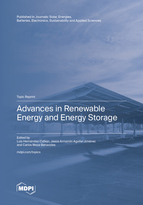Topic Menu
► Topic MenuTopic Editors



2. Electronics Engineering School, Instituto Tecnologico de Costa Rica, Cartago 159-7050, Costa Rica
Advances in Renewable Energy and Energy Storage

A printed edition is available here.
Topic Information
Dear Colleagues,
Moving towards a global energy matrix based on renewable energy technologies is a topic of special interest to the world community to mitigate environmental pollution and climate change. Proposing more efficient technologies, with higher energy integration and lower costs, will increase the adoption of renewable energies and lead efforts towards sustainable development.
Energy storage systems are a fundamental part of energy systems, as they provide continuity, stability and security of service. Their incorporation into renewable energy technologies is of the utmost importance to avoid intermittency, prolong their use and decarbonize centralized and distributed electrification systems.
We would like to invite submissions of new proposals regarding the research, development and implementation of renewable energy and energy storage technologies, seeking to establish a framework of current and future state of the art for those interested in a broad transdisciplinary space.
Topics of interest for this publication space include, but are not limited to, the following:
- Photovoltaic and thermal solar energy;
- Wind energy;
- Hydropower;
- Geothermal energy;
- Biomass energy;
- Nuclear energy;
- Efficient use of energy;
- Microgrids;
- Distributed and centralized generation;
- Hybrid generation systems;
- Control of electrical systems;
- Artificial intelligence applied to clean energy systems;
- Power generation, transmission and distribution;
- Cogeneration, trigeneration and multigeneration;
- Mechanical, thermal, chemical and other energy storage;
- Energy storage in batteries: lead–acid, lithium–ion, nickel–cadmium, flow batteries, others.
Prof. Dr. Luis Hernández-Callejo
Dr. Jesús Armando Aguilar Jiménez
Prof. Dr. Carlos Meza Benavides
Topic Editors
Keywords
- photovoltaic and thermal solar energy
- wind energy
- artificial intelligence applied to clean energy systems
- microgrids
- energy storage in batteries: lead–acid, lithium–ion, nickel–cadmium, flow batteries, others
- control of electrical systems
- renewable energies
Participating Journals
| Journal Name | Impact Factor | CiteScore | Launched Year | First Decision (median) | APC |
|---|---|---|---|---|---|

Applied Sciences
|
2.7 | 4.5 | 2011 | 16.9 Days | CHF 2400 |

Batteries
|
4.0 | 5.4 | 2015 | 17.7 Days | CHF 2700 |

Electronics
|
2.9 | 4.7 | 2012 | 15.6 Days | CHF 2400 |

Energies
|
3.2 | 5.5 | 2008 | 16.1 Days | CHF 2600 |

Solar
|
- | - | 2021 | 16.9 Days | CHF 1000 |

Sustainability
|
3.9 | 5.8 | 2009 | 18.8 Days | CHF 2400 |

MDPI Topics is cooperating with Preprints.org and has built a direct connection between MDPI journals and Preprints.org. Authors are encouraged to enjoy the benefits by posting a preprint at Preprints.org prior to publication:
- Immediately share your ideas ahead of publication and establish your research priority;
- Protect your idea from being stolen with this time-stamped preprint article;
- Enhance the exposure and impact of your research;
- Receive feedback from your peers in advance;
- Have it indexed in Web of Science (Preprint Citation Index), Google Scholar, Crossref, SHARE, PrePubMed, Scilit and Europe PMC.

